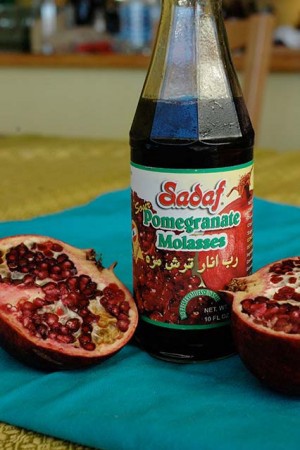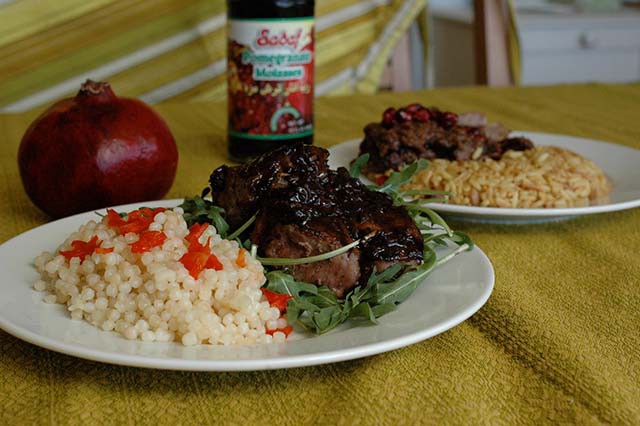Pomegranate Molasses: The Sweet-And-Sour Syrup
by Ben Choi

Pomegranates: beautiful and delicious, but they scare me a little. All those little geometrically arranged blood-red seed pods embedded in fleshy nutritive pulp. If M.C. Escher, H.R Giger and H.P. Lovecraft got together and designed a fruit, it would be the pomegranate. I’m not alone in my ambivalence. Some say it was a pomegranate, not an apple, with which the serpent tempted Eve under the Tree of the Knowledge of Good and Evil. And if in some ancient cultures, the pomegranate was a symbol of fertility and abundance it was also, according to Greek myth, the Fruit of the Dead that trapped Persephone in the underworld.
But, once you’ve fallen to the hypnotic charms of this alien-death-fruit, you’ll find its straightforwardly tart flavor the perfect inspiration for an extremely versatile condiment called pomegranate syrup or, more commonly, pomegranate molasses. The appeal of pomegranate molasses rests entirely in its taste-simplicity. It’s an uncomplicated sweet-and-sour factor that makes this stuff freakishly useful in the kitchen. The flavors just pop. It goes great with lamb, chicken and even salmon. You can use it in vinaigrettes, gastriques, agradolces and barbecue sauces. You can use it in cocktails, mocktails, wassails and shandies. Any place where sweet meets sour. Here are a handful of recipes to give you some ideas.
Pomegranate molasses is produced by simply boiling pomegranate juice, lemon juice and sugar until it becomes the consistency of, well, molasses. You can make your own or find a very decent commercial version in well-stocked supermarkets and in Middle Eastern groceries. The brand I use, Sadaf, is from Lebanon, and is available in stores and online for under 4 dollars.
Koresht-e Fesenjan
This is a very traditional Persian Dish that really spotlights the bright acidity and controlled sweetness of pomegranate molasses. You’ll find these qualities are an excellent counterpoint to the tannins and oils that the walnuts bring to the party.
(Serves 2–3)
4 chicken thighs
½ of a medium onion
¼ cup water
2 cups walnuts toasted
1 ½ cups water
1/2 cup of pomegranate molasses
a pinch of cinnamon
20 strands of saffron steeped in a tablespoon of hot water
salt
pepper
Toast the walnuts in a hot cast iron skillet over medium heat. Stir continuously and get them just a uniform light brown, over, say 4 minutes. Remove from heat and let cool. When they cool place them in the bowl of a food processor and pulse until you get them to the consistency of course, moist sand. Put the nut powder in a heavy-bottomed saucepan over medium heat and add 1 ½ cups water. Incorporate mixture well, and bring to a ploppy slow boil. It should remind you of Maypo or Malt-o-Meal. Reduce heat to a low simmer, and keep it at this pace for 45 minutes. You may have to swirl in a couple of tbsp. of extra water if it’s looking too dry and pasty. You don’t want to stir this too much, as you want to eventually be seeing oil bubbling up to the surface; this percolation action is important.
Take this time to deal with the chicken. Preheat a cast-iron skillet on high for 3 minutes. Salt and pepper the thighs to your liking as the pan gets hot. Now put them skin-side down into the skillet and brown them untill the skin releases most of its schmaltz and turns a nice deep golden brown. Flip the thighs so they’re skin-side up and add chopped onions. When onions are translucent, reduce heat to medium low, add ¼ cup water and cover tightly and immediately. Let thighs steam in their own oniony funk for 20 minutes and turn off heat.
Now back to the nuts. After stewing for 45 minutes, they should look something like the last couple of inches of one of those Starbucks Frappuccino drinks, kinda slushy but with liquidy edges. At this point add pinch of cinnamon, pomegranate molasses and saffron mixture. Bring back up to simmer and let it bubble for an additional 15 minutes.
At this point the nut mixture should now be a nice maroon/brown. Incorporate chicken and contents of skillet into nut pot. Blend well and bring back up to simmer. Stay the course for just 30 more minutes to let the flavors meld. Salt and pepper to taste (you won’t need much more salt). Garnish with pomegranate seeds and serve with a pilaf or similar rice dish.

Lamb Chops with a Pomegranate Pan Sauce
(serves 2)
4 lamb loin chops, well trimmed of fat and silver skin
salt and pepper
2 tbsp butter in two pats
the white and light green parts of 3 green onions sliced thinly crosswise
⅓ cup red wine
1 tbsp. pomegranate molasses
1 tbsp. balsamic vinegar
⅓ cup chicken stock
salt and pepper
Preheat cast iron skillet over high heat for about 7 minutes. While that’s going on, salt and pepper chops. Lay chops into hot skillet with the more photogenic side down. It’s also nice to position your chops with the meaty side pushed up against sides of pan like numbers on a clock. That way the meat will cook to a more uniform thickness because the side that is unsupported by bone is made to stand up straight against the wall. Nobody likes slouchy lamb.
When you see that the down side has a nice deep-brown char, flip. Cook to your preferred level of doneness, though I recommend the red side of medium rare. Use the finger test to know when you’re at the right level. Remove chops from skillet and set aside. Turn off the heat.
Now, using the residual heat in the skillet, melt one pat of butter. To that add the green onions and saute for say 15 seconds. Deglaze skillet with red wine, should be pretty dramatic. Quickly blend in pomegranate molasses with whisk. Turn the heat back up to medium-high and whisk in balsamic vinegar and chicken stock. In a minute or two the sauce should thicken to the point where it adheres evenly to the back side of a spoon. Remove from heat and whisk in remaining pat of butter. Spoon liberally over chops and serve lamb with Israeli couscous.
Pomegranate Vinaigrette
Combine 1 tsp. grainy Dijon mustard, 1 tsp. pomegranate molasses, 1 tsp. white balsamic or Champagne vinegar in a small glass bowl; blend well. Blend in 1 tbsp. extra virgin olive oil with small whisk until emulsion is achieved. It should be enough to dress a salad for 2- 4.
Shirley Temple Black (Pomegranate Brandy Fizz)

Dissolve 1 tbsp. pomegranate molasses in 1 jigger (1.5 oz) brandy in the bottom of a small cocktail shaker. Take 2 or 3 sprigs of fresh thyme betweeen your palms and rub to release oils; add to shaker with 2 or 3 cubes of ice. Shake. Strain into a cocktail glass. Add a healthy splash of seltzer. Garnish with cocktail onion.
Chismosa (Pomegranate Champagne Cocktail)
In a champagne glass or flute, dissolve 1 tbsp. pomegranate molasses and 2 dashes of Angostura bitters in 3 oz. grapefruit juice. Top with 3 oz. Prosecco, cava or Champagne.
Greek Yogurt with Pomegranate Molasses and Pistachios
For a simple treat sprinkle some lazily crushed pistachios over some plain Greek yogurt and drizzle with a tablespoon of pomegranate molasses.
Crumbled Roquefort Cheese with Pomegranate Honey
Just crumble Roquefort or any blue cheese you like over some crackers and drizzle with 1 part pomegranate molasses and 1 part raw honey, well blended. It’s a great snack to enjoy while reading a book.
Previously: Gochujang and Habanero Salsa
Ben Choi lives in the SF Bay Area with his wife Erica and dog Spock. He’s considering a raw food diet.
